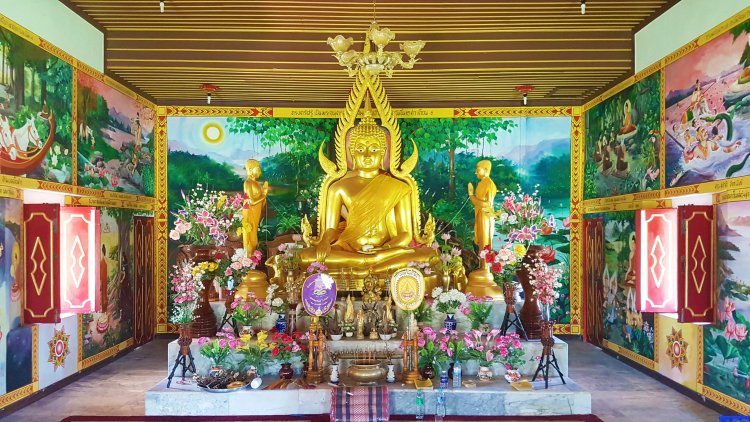Buddhist Festivals in India: A Spiritual Journey Through Sacred Celebrations
India, the birthplace of Buddhism, is a land of immense spiritual significance. From the peaceful town of Bodh Gaya, where Siddhartha Gautama attained enlightenment under the Bodhi Tree, to the serene monasteries tucked away in the Himalayas, Buddhism has deep roots in Indian culture. Buddhist Festivals in India are more than just religious observances; they are vibrant, spiritual, and deeply symbolic celebrations that connect devotees with the teachings of the Buddha. These festivals offer a unique glimpse into the soul of Buddhist traditions, drawing people from around the world in search of peace, reflection, and enlightenment.

India, the birthplace of Buddhism, is a land of immense spiritual significance. From the peaceful town of Bodh Gaya, where Siddhartha Gautama attained enlightenment under the Bodhi Tree, to the serene monasteries tucked away in the Himalayas, Buddhism has deep roots in Indian culture. Buddhist Festivals in India are more than just religious observances; they are vibrant, spiritual, and deeply symbolic celebrations that connect devotees with the teachings of the Buddha. These festivals offer a unique glimpse into the soul of Buddhist traditions, drawing people from around the world in search of peace, reflection, and enlightenment.
1. Buddha Purnima – The Most Revered Buddhist Festival
Buddha Purnima, also known as Vesak, is the most important among all Buddhist Festivals in India. Celebrated on the full moon day in April or May, this sacred occasion commemorates the birth, enlightenment, and Mahaparinirvana (death) of Lord Buddha. Pilgrims gather in large numbers at key Buddhist sites such as Bodh Gaya (Bihar), Sarnath (Uttar Pradesh), and Kushinagar (Uttar Pradesh) to pay homage.
Temples are beautifully decorated with flowers and lights. Devotees engage in chanting, meditation, sermons, and processions. Offerings of flowers, incense, and candles are made to the Buddha. The air is filled with a sense of peace and reverence as people reflect on the teachings of compassion, humility, and mindfulness.
2. Losar – Tibetan Buddhist New Year
Celebrated with grandeur in the Himalayan regions of India like Ladakh, Sikkim, and Arunachal Pradesh, Losar marks the Tibetan New Year. Falling in February or March, it is one of the liveliest Buddhist Festivals in India, blending religious rituals with cultural exuberance.
Monasteries host elaborate prayers and masked dances known as Cham, where monks wear ornate costumes representing deities and demons. Homes are cleaned and decorated, and families come together to prepare traditional food and exchange greetings. The festival is not only a celebration of the new year but also a way to drive away evil spirits and invite positive energy.
3. Hemis Festival – A Spiritual Extravaganza in Ladakh
Held in June or July at the Hemis Monastery in Ladakh, the Hemis Festival is dedicated to Guru Padmasambhava, the founder of Tibetan Buddhism. The festival commemorates his birth and his victory over evil forces.
The main highlight is the sacred masked dance, or Cham Dance, performed by monks in vibrant silk robes and intricate masks. Each dance narrates stories of good triumphing over evil, aligning with Buddhist philosophy. The festival also includes music, rituals, and the display of the monastery’s rare thangka (sacred tapestry), which is unveiled only once every 12 years.
4. Kalachakra Festival – A Rare Spiritual Gathering
Kalachakra, meaning “wheel of time,” is a rare and significant event in the Buddhist world. Organized at intervals depending on the Dalai Lama’s schedule, it often takes place in locations like Bodh Gaya. It is a major draw for spiritual seekers globally and is considered one of the most profound Buddhist Festivals in India.
During the festival, the Dalai Lama imparts the Kalachakra Initiation, which includes teachings, prayers, and the creation of an intricate sand mandala representing the universe. The rituals are deeply symbolic and aim to promote world peace and harmony. The gathering becomes a melting pot of faith, devotion, and international brotherhood.
5. Ullambana – The Festival of Ancestors
Known as the Festival of Hungry Ghosts, Ullambana is celebrated by Mahayana Buddhists to honor ancestors and departed souls. While more widely observed in China and Southeast Asia, certain Indian Buddhist communities, especially in Maharashtra and Bihar, also partake in this ritual.
Offerings of food, water, and incense are made to please restless spirits and guide them toward peace. The festival is rooted in the story of Maudgalyayana, a disciple of Buddha, who sought to relieve his mother from suffering in the afterlife. Ullambana reflects the Buddhist belief in karma, filial piety, and the importance of compassion even beyond death.
6. Kathina – The Robe Offering Festival
Kathina is celebrated at the end of the three-month monastic retreat known as Vassa, which takes place during the rainy season. Celebrated around October-November, it is a time when lay followers offer new robes and essentials to monks as a gesture of gratitude.
Although primarily celebrated in Theravada Buddhist countries, the tradition is upheld in India’s Buddhist communities, especially in regions like Nagpur and parts of Maharashtra. The spirit of Kathina lies in the bond between the monastic community and laypeople, fostering mutual respect and support.
Conclusion
Buddhist Festivals in India are not just rituals or events marked on a calendar; they are immersive spiritual journeys that reflect the profound wisdom of the Buddha’s teachings. From the enlightenment of Buddha Purnima to the colorful dances of Hemis and the solemn rituals of Ullambana, each festival tells a story of faith, compassion, and inner peace.
For travelers and spiritual seekers, attending these festivals offers a chance to connect deeply with Buddhist philosophy, interact with diverse communities, and experience India’s rich cultural tapestry. Whether you are a devout follower or simply curious about the spiritual traditions of the East, these sacred celebrations will leave you enlightened and inspired.

What's Your Reaction?

















.jpg)